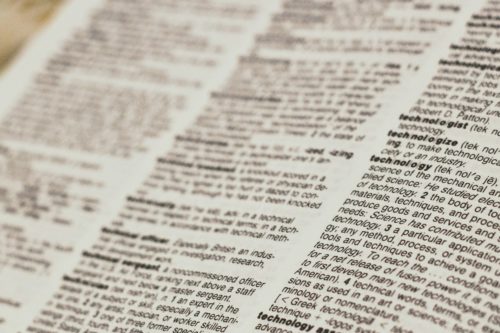#FunFactFriday – Industry Jargon Explained
Abbie and I were working on a project together and she used the term “widow” when editing one of the documents. Assuming she meant “window,” I spent about 30 minutes trying to figure out what window I left open on my computer before asking her what she meant. Indeed, she did mean widow. Not something I had learned in journalism school, a widow – and its companion term, orphan – refers to when a last word or short last line of a paragraph falls at the top of a page or column and considered undesirable. An orphan is when the first line of a paragraph sits at the bottom of a page by itself. And while we’re at it, a “runt” can occur anywhere throughout a page or column, and it’s when the last line found in a paragraph ends with a single word; this often happens with hyphenated words.
In honor of the term I learned last week, May’s Fun Fact Friday focuses on some journalism and public relations terms – both old and new – defining them for anyone unaware:
Above the Fold: This started as a literal term, meaning a story that appears in the print newspaper above the physical fold. These easy-to-see stories are thought to have heavier and meatier weight than those below the fold.
Backlink: This is linking from one site to another online such as a hyperlink or even an ad link.
Beat: The area or topic assigned to a reporter. For example, the real estate beat reporter or the concert beat reporter. This can also mean geographical beat. For example, Phoenix beat or Mexico beat, meaning that reporter writes on a particular region.
Boilerplate: This is a standard paragraph that gives the 411 on a brand, typically found at the end of every news release. It is three to five sentences and should include a link to the website and the brand’s mission statement.
Cutline: The sentence or two that accompanies a photo in a story that explains who is in the photo and what they are doing. Generally, this is also where the photo credit is placed (though some have this in main parts of their stories now as well).
Dateline: The dateline is a line of text that indicates the date of the news release and city (and state) from where it is being sent. Datelines are used in wire service copy and are commonplace when writing news releases.
Dek or Deck: I just call this one the sub-headline or heading of a story. So, the little teaser about the story under the formal title or headline.
Hed: This is the title – or headline – of a story. Some same that hed refers to the headline of a news story while headline is the heading or title of an article. And not to be confused with the verb headline as in having top billing or to be the main attraction.
Lede: This is – surprise – the first sentence (or LEAD) of a story. It is spelled that way to avoid being confused with LEAD, meaning the stuff in pencils or the person in charge. Could also be referred to as graf (see below).
Graf: As it sounds, this is shorthand for paragraph. No clue why the F versus PH. I am just guessing, but so not confused with an actual graph? Could also be referred to as lede (see above).
Macro-Influencer: I always call this “not a celebrity” influencers. So those folks out there with social media followings upwards of 20,000 to 100,000 – or more – followers, but not at celebrity levels, which are often in the millions.
Micro-Influencer: Like macro above, these are generally non-celebs with followers in the 5,000 to 20,000 range (though it depends on the region and industry or vertical).
Shot List: This is a list that someone makes for a videographer or photographer to denote the exact images they require during an event or shoot.
Stet: This one I had to look up. I know it means “keep it as is” in editing but found out it is actually Latin for “let it stand.” Editors would use this phrase when editing by hand (as in no tracked changes in word) meaning that one editor believes something should change, but the editor with the final say-so wants it to stay as it was.
It should be noted that most businesses and brands have their own “jargon.” To get help from us on how to avoid it in your marketing communications, click here.

